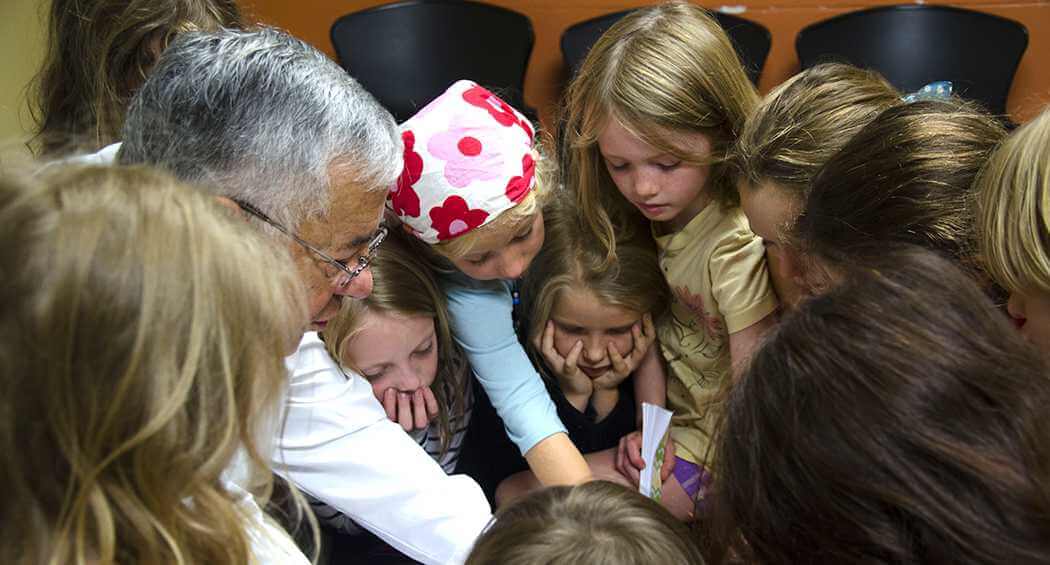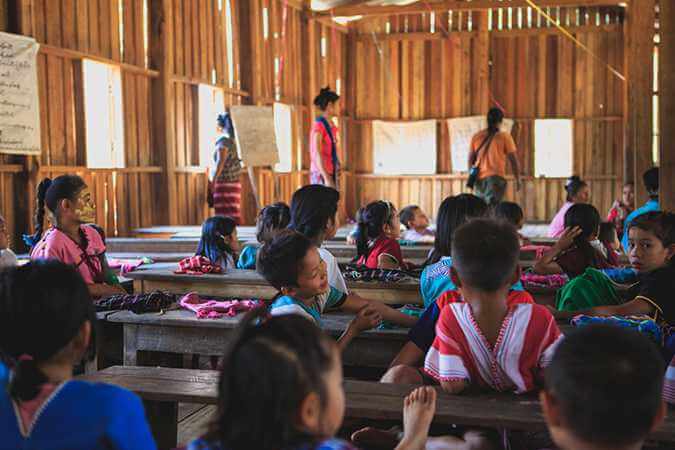For many people, when they discover something good, they want to share it; as parents, that was the case for us with the Sudbury Valley School in Framingham, MA. Of course, it was gratifying for us to witness the transformation of our then 15-year-old son from his despair into the young adult he was meant to be, and I would be less than truthful if I did not say that we felt somewhat vindicated by the developments in his life both during his time at Sudbury Valley and after, as I had found myself, by necessity, defending and supporting our son over and over during his time in public school.

To that end, I shared the information about the Sudbury Valley School with a friend whose son was not “making it” in public school, and his experience would underscore for me one of the most valuable underlying tenets of Self-Directed Education. Unlike our son, this child was not motivated (seemingly) to do anything, and according to reports by his mother, he spent his visiting week at the Sudbury Valley School sitting under a tree, eventually getting stung by a bee. This development was particularly troubling for his parents because they were hoping that their son would suddenly become motivated by the freedom that a school like Sudbury Valley offers.
But let’s consider why this young man did not respond as his parents had hoped. A basic underlying philosophy of the Sudbury Valley School is that all children are born with the inner drive and curiosity to learn. However, in a conventional school setting, students are often forced to sit and listen to things that do not interest them, and simultaneously denied the opportunity to engage in the things that they are in fact motivated to learn. It is reasonable to deduce that these students could lose their motivation to engage at all, and may not be able to easily retrieve that motivation when such restrictions are lifted. Dan Greenberg, the founder of the Sudbury Valley School in Framingham describes it this way in his book, A Place to Grow: The Culture of Sudbury Valley School.
Most young people who enter our school have to go through a period of painful adjustment to freedom. ... [They] are rarely able to shake off all the effects of prior exposure to external control ... they usually find it [harder] to develop internal feedback mechanisms to replace external controls. ... Those who adjust most easily are those who never went to another school ... or who were ferociously rebellious in other schools and held their freedom more precious than anything. (p. 181)
Our son clearly fell into the “ferociously rebellious” category. Although he was an extremely bright and capable student, his refusal to comply with the rigid rules and requirements of public school, as well as his determination to engage in only those things that were of interest to him, nearly earned him at least two mental health diagnoses and a nonverbal learning disability diagnosis. And it is this contradiction, which is inherent in the tension between the needs of a child and the questionable constraints of a public school education, that lies at the heart of the connection between Self-Directed Education and children’s mental health and development.

Most parents, when asked, would say that they want their children to grow up to be self-reliant, independent and responsible. Yet, for many children the development of these qualities is inadvertently discouraged by the very conditions of the system in which they must exist. Conventional schooling, which focuses on standardized measures of achievement, requires that students conform to teacher-centered instruction and required curricula which effectively limits their exposure to opportunities for independent decision-making. This framework can serve to frustrate strong-willed and self-determined students like our son, but it can also be counter-productive for more reticent students who would benefit from the opportunity to develop confidence in making their own decisions, and experiencing the consequences of those decisions.
At the Sudbury Valley School, our son’s strong desire for self-determination was appreciated and nurtured by the staff rather than discouraged or disparaged. It was treated as an asset, which enhanced our son’s motivation to achieve his own goals. He became well regarded by the staff as a responsible and hardworking student who other students began to rely on for help. He was accepted for the individual that he was and for the things he wanted to accomplish. There were no preconceived notions of what he should be like or what decisions he should make for himself. His individuality was embraced, and not surprisingly he developed mutually respectful relationships with staff that eventually broke down his resistance to hearing others’ thoughts because, unlike most of his previous experiences, the adults in his life were no longer telling him that they knew better than he did about what he wanted or needed for himself.
This climate of acceptance and encouragement stood in stark contrast to the battle of wills that had consumed his public school experience. In fact, in this environment, the issue of authority became a non-issue, because authority in a setting such as Sudbury Valley is not embedded in a construct that is designed to delegate more power upon one person than another. Rather, it is embedded in the acquired influence of the staff, which develops over time through collaborative relationships with students and the respectful and supportive tone of those relationships, as well as the collective aspects of the school community itself.
Naturally, I have wondered about other seemingly more conforming or compliant children and how such a setting may impact their development. Recently, I discussed this issue with our now thirty-four year old daughter, who unlike her brother, remained in public school and had a very different experience. We spoke about the freedom that is inherent in a school such as Sudbury Valley, and the lack of direction from authority figures; her insight was notable and worth repeating. She enjoyed the structure of public school and liked having received guidance and direction; but she wondered whether, if she had attended a school like Sudbury Valley from the beginning, she would have just naturally relied on herself to make decisions and to create whatever structure she needed for herself. She also wondered whether making decisions, particularly more consequential ones, would be less anxiety producing for her now had she had the freedom to make those decisions from the beginning.
We also spoke about the issue of self-discipline, and in this instance, she questioned whether the school’s requirements of doing homework and meeting certain academic goals, even ones that didn’t particularly interest her, helped prepare her to be successful in college and in law school. I thought about the connection between motivation and self-discipline, and how students who attend the Sudbury Valley School seem well able to harness the self-discipline they need to be successful when they decide that there is something specific that they want to accomplish.

It is an interesting question about what drives the ability to accomplish one’s goals. In the case of our daughter, she was motivated to attend and complete law school. Without the inner motivation to achieve this personal goal, it is difficult to imagine that she would have been able to sustain the level of concentrated study that is required to complete such a program. Did reading and writing assignments in public school provide her with the opportunity to “practice” the demands she would face in law school? Maybe. Would the lack of those requirements have prevented her from being successful in completing law school? My sense is that my daughter would have been an avid reader and engaged in creative writing regardless of where she went to school.
This highlights one of the common and most profound differences between Self-Directed Education and conventional education. In a school such as Sudbury Valley, it becomes the student’s responsibility to achieve his or her own goals; they do not rely on someone else to assume that responsibility for them. And the development of responsibility in our children is something all parents concern themselves with.
A common phrase we often hear is “Why can’t you behave responsibly”? Haven’t we all heard (or said) that at one time or another? But what experiences actually contribute to a child’s development of personal responsibility? It may not be enough to require that our children perform the tasks that we assign them, such as school homework or taking out the trash. If we expect our children to develop real personal responsibility, they should have the opportunity to make and to debate real-life decisions and to experience the consequences of those decisions, whether good or bad.
At Sudbury Valley, all students and staff have a voice in the welfare of the collective community. Students are invited and encouraged to participate in decisions that impact the school community at the school meeting. Through this process, the idea of personal responsibility becomes real and is able to be practiced in a very real way. It is not some vague concept that your parents or teachers talk about; and it does not always develop as one might hope from a directive to accomplish designated weekly assignments, or as a reprimand for some transgression of childhood.
At the Sudbury Valley School, students can and do rely on themselves to shape and direct their own lives. Their education becomes their responsibility, and it is their personal growth that supports them in attaining their personal goals. In 2005, staff of Sudbury Valley solicited feedback from former students regarding a myriad of issues relating to their school experience as it related to their post-graduate experiences. The results were detailed in a book entitled The Pursuit of Happiness; The Lives of Sudbury Valley Alumni. One such student described his experience in the following way:
“I think that my confidence in myself, and my ability to tackle whatever it is I want to tackle, in large part came from having been given the trust to shape my own education, and the trust that I would know what was best for myself from a young age. I never find myself in a situation where I feel like I don’t have the tools to tackle it. Sometimes it takes a while, if it’s something new; but I never feel like I don’t have the inner strength and direction and ability to do whatever it is.” (Greenberg, Sadofsky & Lempka, 319-320)
In conventional education, students are increasingly required to meet goals that are set for them by school administration in the service of promoting them to college, so that the “responsible” student unwittingly enters into an unspoken contract with their school to perform all of the necessary tasks designed to achieve this goal. Somewhere along the way, the student develops an understanding of their primary goal to be that of getting into college, and further, into the best college they can. In reality, however, this may not be the best college for them but rather the one that has the highest overall rating. This goal often becomes devoid of any real consideration about interests, desires, or what one truly finds enjoyable in life.
Recently, I revisited the Sudbury Valley School, and during my visit, three little girls came into the office, one in tears; predictable recriminations ensued among the girls while they attempted to plead their individual innocence. But here is what was different. The staff truly “knew” these three little girls because the atmosphere of open communication with staff allowed for the development of that insight and those deeper relationships, which in turn enabled the staff to assist these little girls to explore their own feelings, their empathy or lack thereof for each other, and ultimately what they would decide to do about it.
The girls were aware that they could make a formal complaint against each other, a complaint that would have been adjudicated at the school meeting, but by the time the intervention was completed, they were in the process of reflecting on their own behavior as it contributed to the conflict and had developed a greater appreciation for each other’s point of view. Their ultimate decision not to make any formal complaints, but rather to reflect on their experience, is just one example of the benefits of a free environment in which issues can be addressed in the moment, and contribute to a child’s personal growth and developing sense of personal responsibility. Further, this ability to know the students becomes even more beneficial as they get older because, in this setting, students do not have to forego relationships they have developed with school staff simply because they matriculate to a different grade.

Many teachers in conventional classrooms perform nothing short of miracles in their attempts to accomplish similar feats each day. However, because they must conform to a very different model which places them at the head of the class, and by necessity must lead the children through a host of prescribed activities and coursework, they do not have the time to foster such relationships.
At the time that we enrolled our son in the Sudbury Valley School, we felt we were doing so primarily in response to his specific needs, but I have since found myself weighing the merits of such a school for any child. I have wondered about the numbers of children who are currently receiving mental health diagnoses because they are forced to conform to the public school setting. And more importantly, I have wondered about exactly what it is we want our children to learn. The pace of change in the world has become frantic, and unrelenting; the idea that, by imbuing our children with a standard set of facts in a standard array of subject areas is going to prepare them for the challenges of today’s world is no longer relevant.
In a recent conversation with our son, he spoke about how his propensity to drive his own agenda in the way that he sees fit is an asset in his current job. His motivation to convince a prospective client to enter into a business contract with his company is unbridled in the same way his resistance to being controlled was unbridled. Because he believes in himself and his ability to drive his own and the company’s agenda, he does not hesitate to resort to strategies that a less confident sales representative would be reluctant to entertain; and this quality has not only served him well, but has garnered the positive attention of his superiors who are impressed with his temerity.
In the end, parents must decide what they want for their child, but when children are struggling in conventional schools, parents should consider the potential damage of that environment on their child’s mental health. By the time our son entered the Sudbury Valley School, he felt beaten down and misunderstood, which predictably led to risky behaviors and an angry and unproductive approach to the world. Likely, we all have been privy one way or another to the disastrous results that can occur when a child’s self-esteem, sense of self-worth and self-realization have deteriorated. Some years after our son graduated from the Sudbury Valley School, he told a relative that he believed that the school had saved his life.
If you enjoyed this article and feel called to give back to ASDE, here are ways you can support our work:
- Donate money
- Share our content with others! Click one of the buttons above to easily share on Twitter, Facebook, or email.
- Consider becoming a Contributor for Tipping Points






